Abstract
This study compared four treatment approaches to cigarette smoking: (1) a nicotine fading procedure, in which subjects changed their cigarette brands each week to ones containing progressively less nicotine and tar; (2) a self-monitoring procedure in which subjects plotted their daily intake of nicotine and tar; (3) a combined nicotine fading/self-monitoring procedure; and (4) a slightly modified American Cancer Society Stop Smoking Program. Thirty-eight habitual smokers were assigned to one of the treatment groups. The study had two goals: (1) to achieve a clinically significant percentage of abstinence, and (2) to reduce the nonabstainers' smoking to a "safer" level by having them smoke low tar and nicotine cigarettes. The 18-month followup results showed that the nicotine fading/self-monitoring group was the most successful: 40% were abstinent and all who had not quit were smoking cigarettes lower in tar and nicotine than their baseline brands. Half the nonabstainers had decreased their rate of smoking relative to baseline while the other half had increased. Furthermore, the fading/self-monitoring group achieved the largest reductions from baseline in daily nicotine and tar intake (61% and 70% respectively). The results suggest that the study's goals were achieved and that the nonaversive combined procedure could be used to treat not only habitual smokers but also smokers with severe cardiovascular and respiratory problems, because it does not have some of the inherent limitations of the successful aversive smoking cessation procedures.
Full text
PDF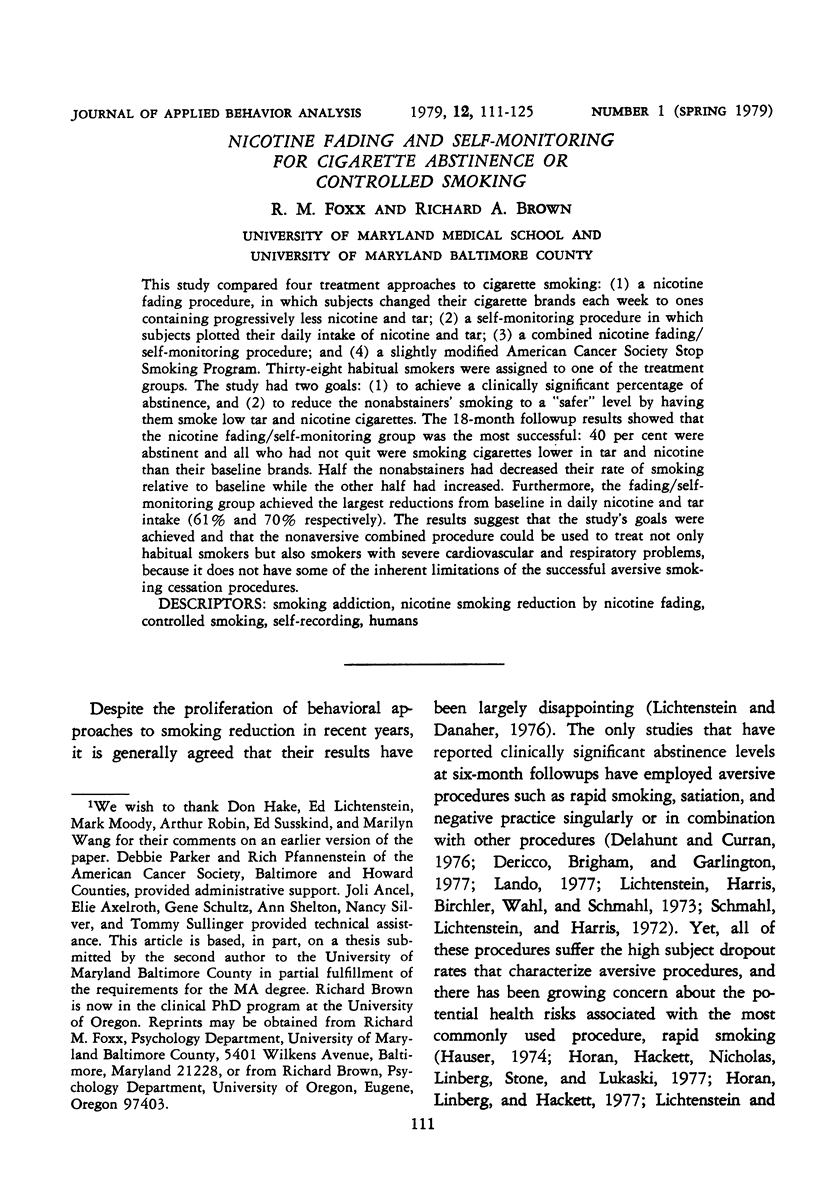
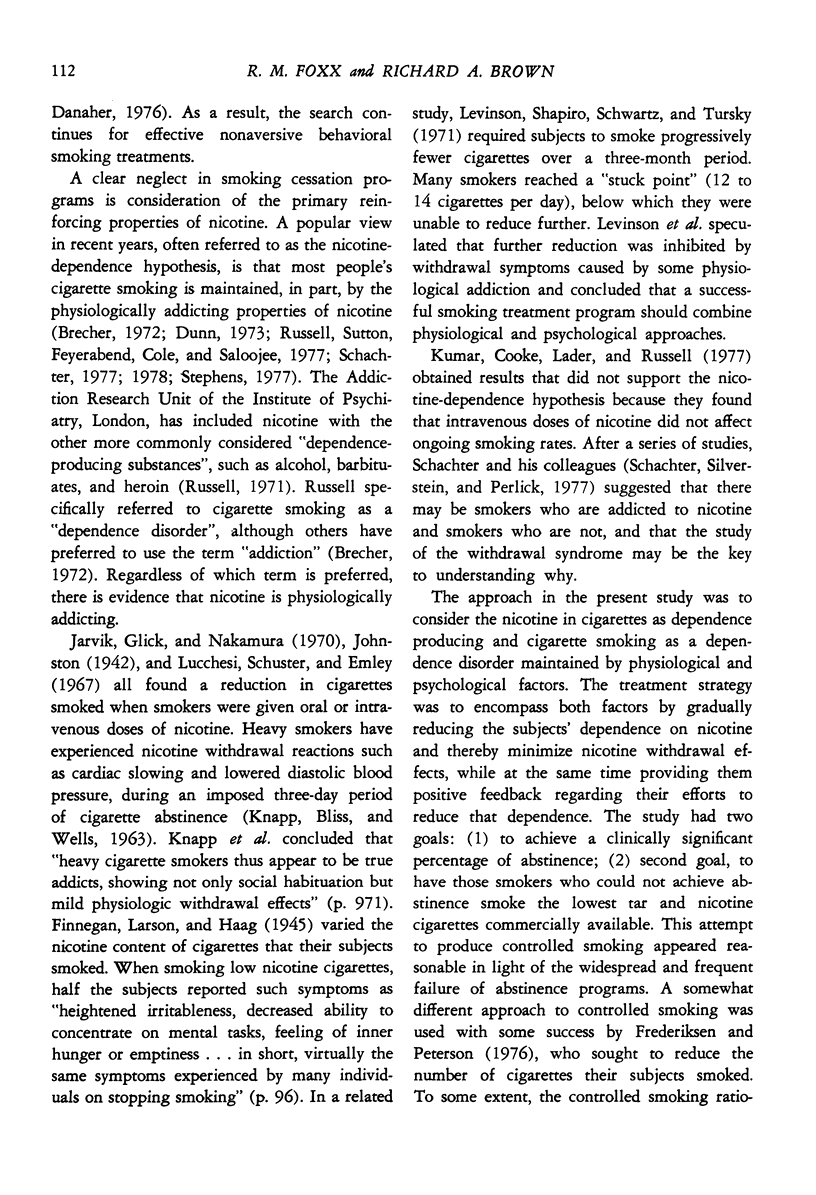
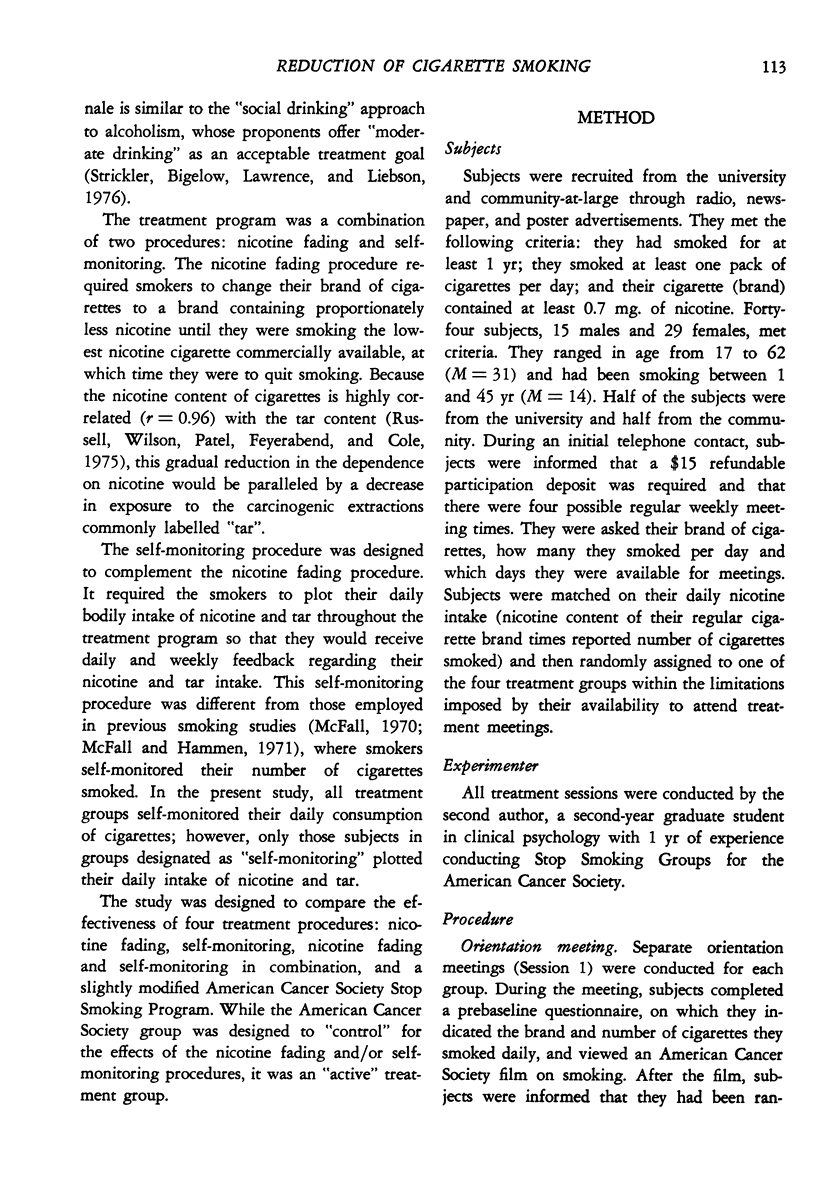

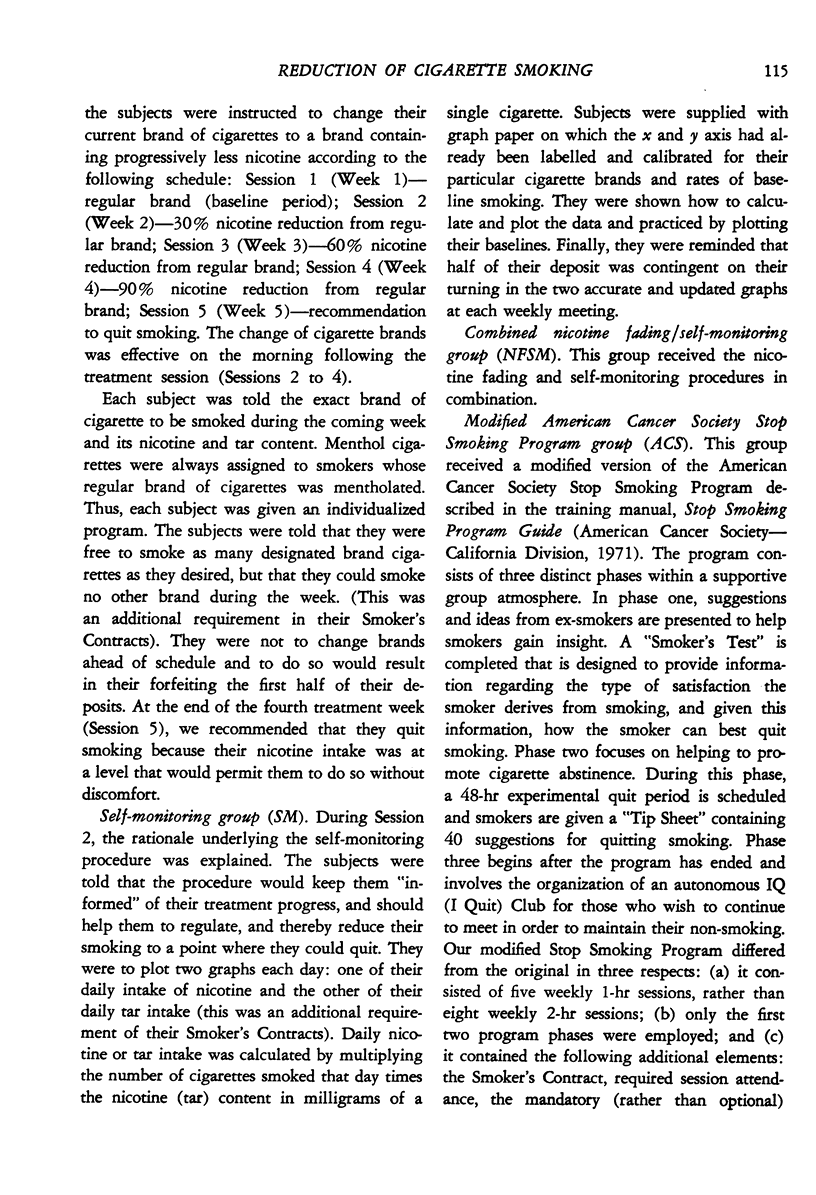
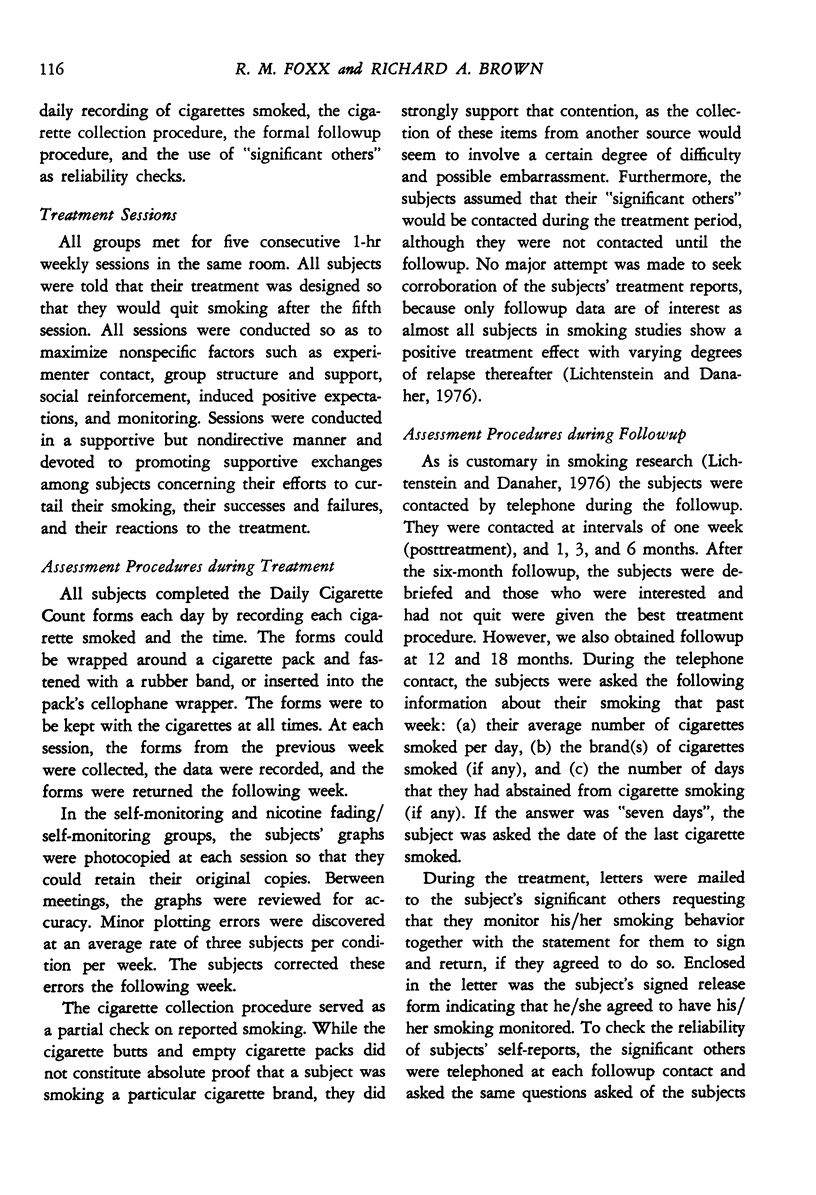

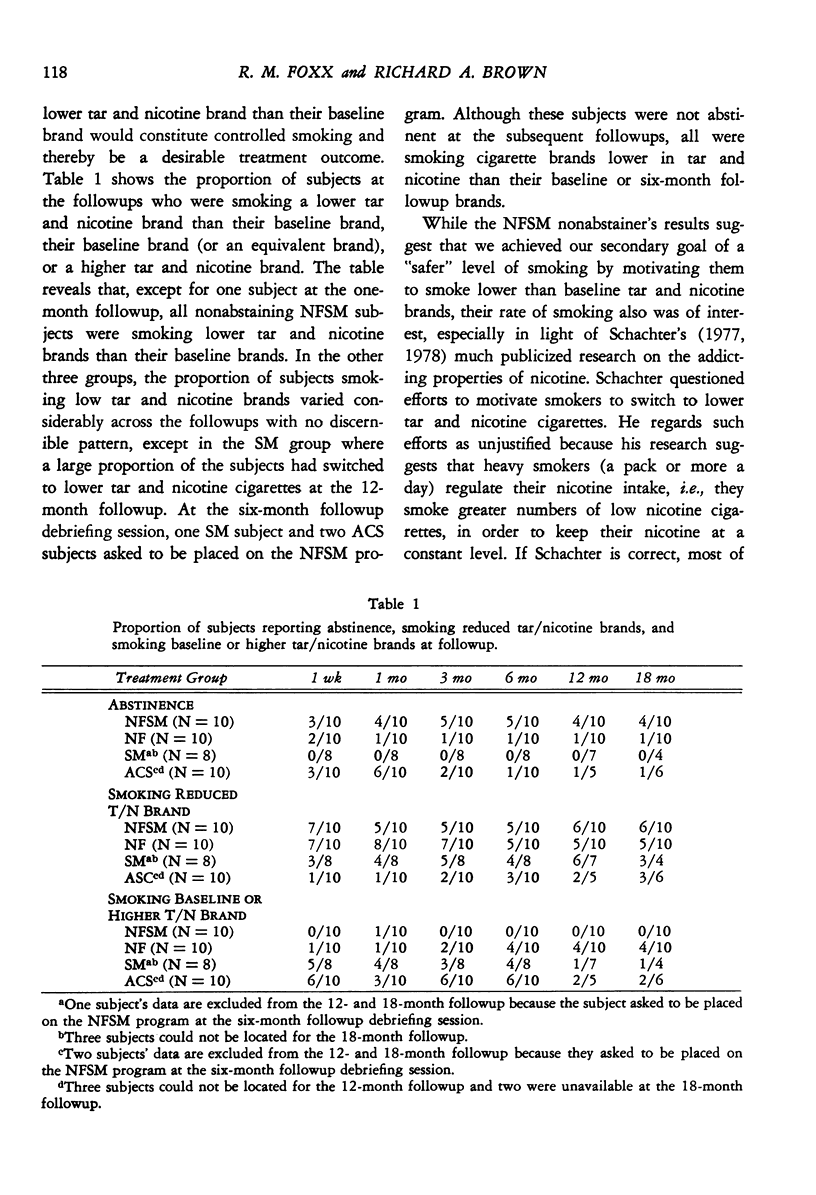
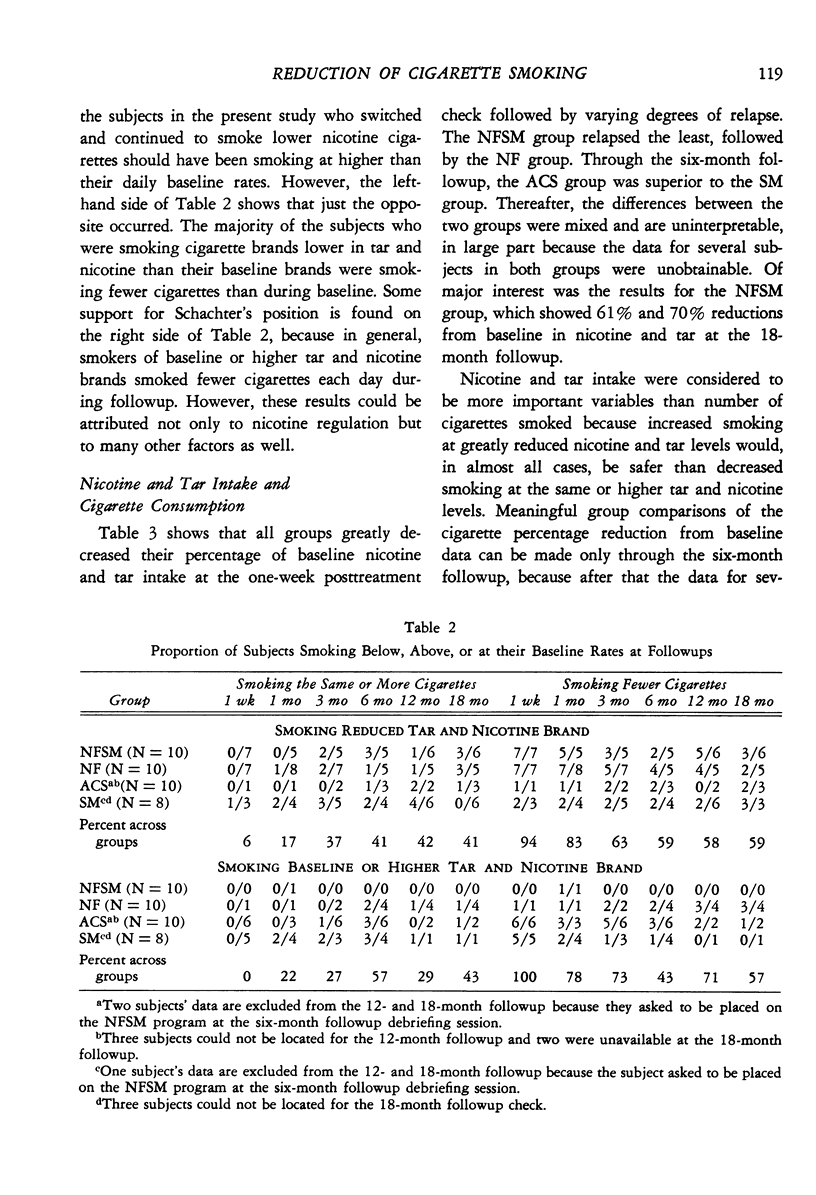

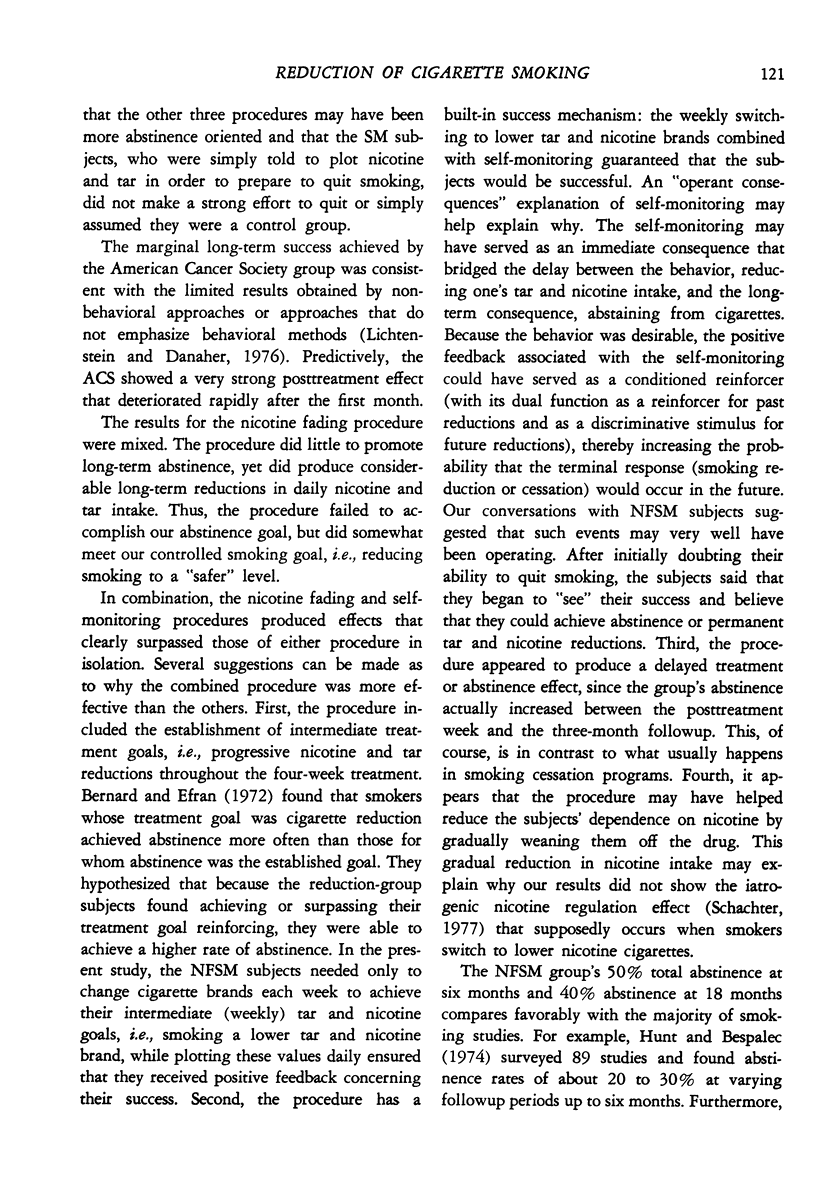
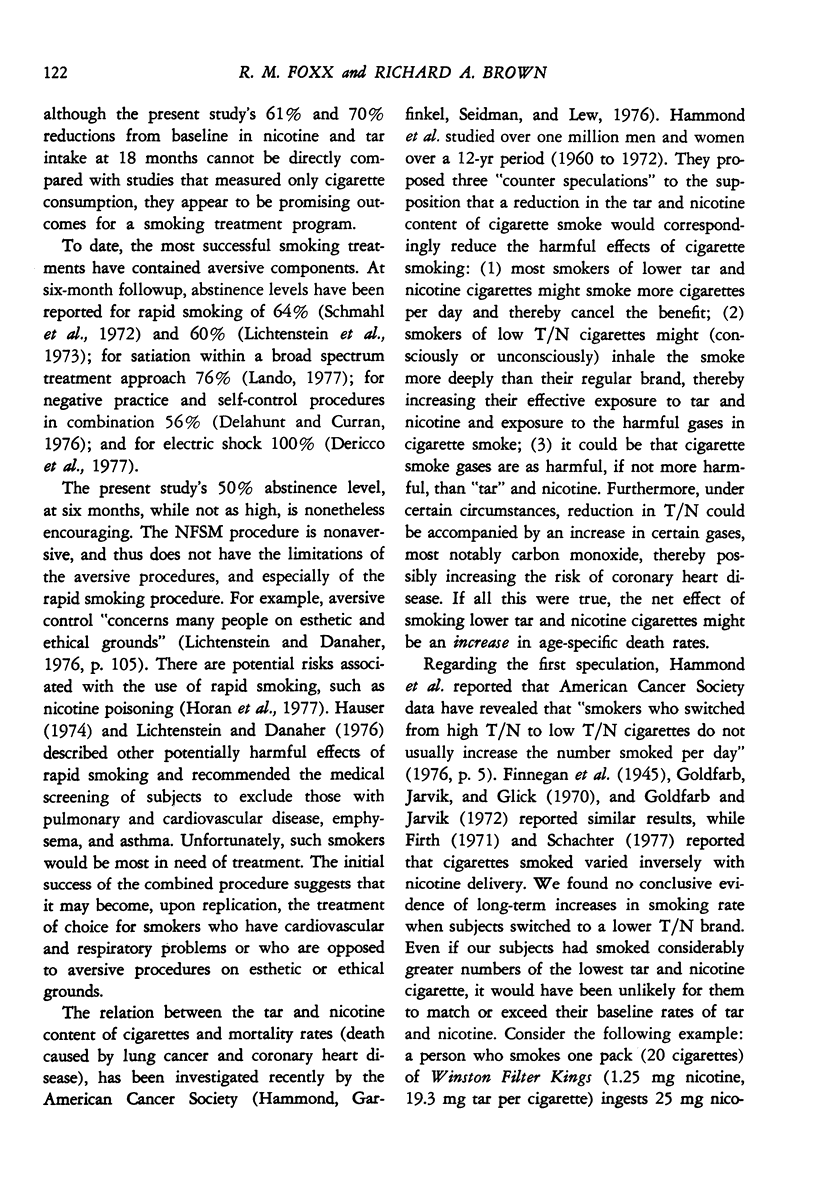
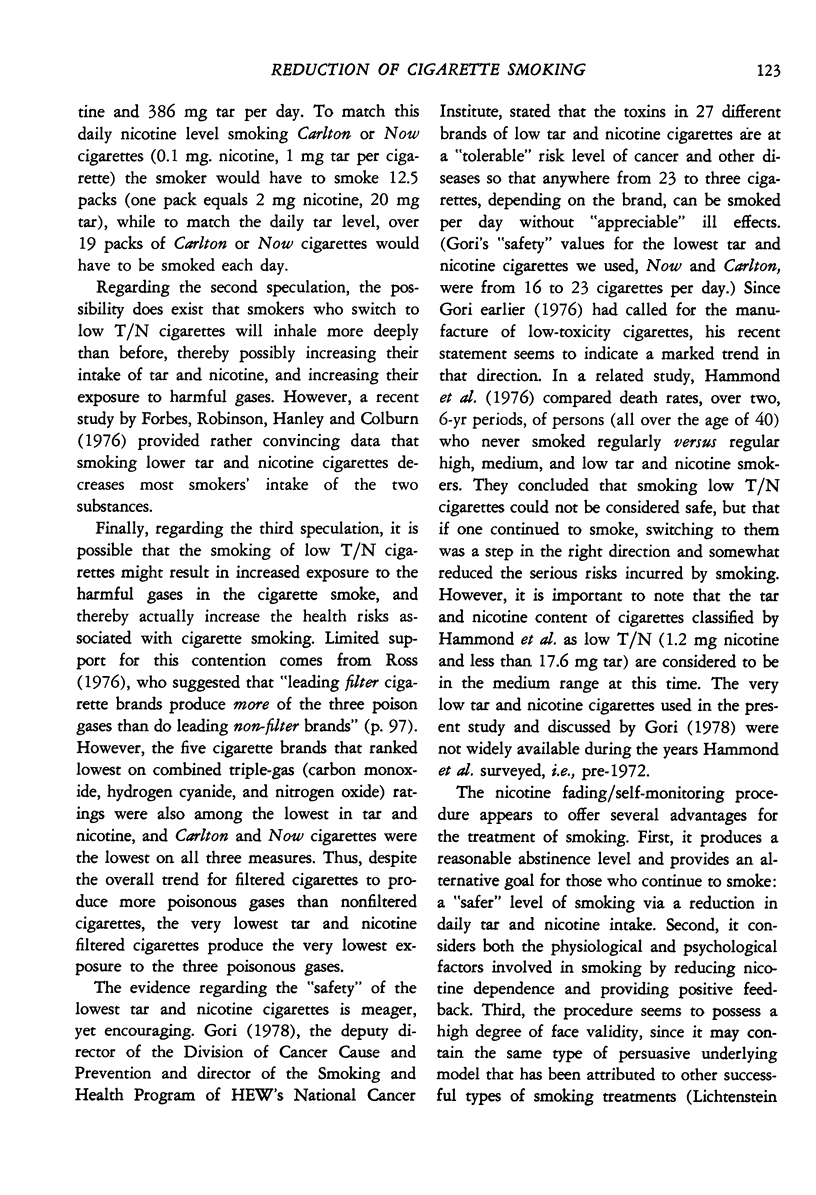

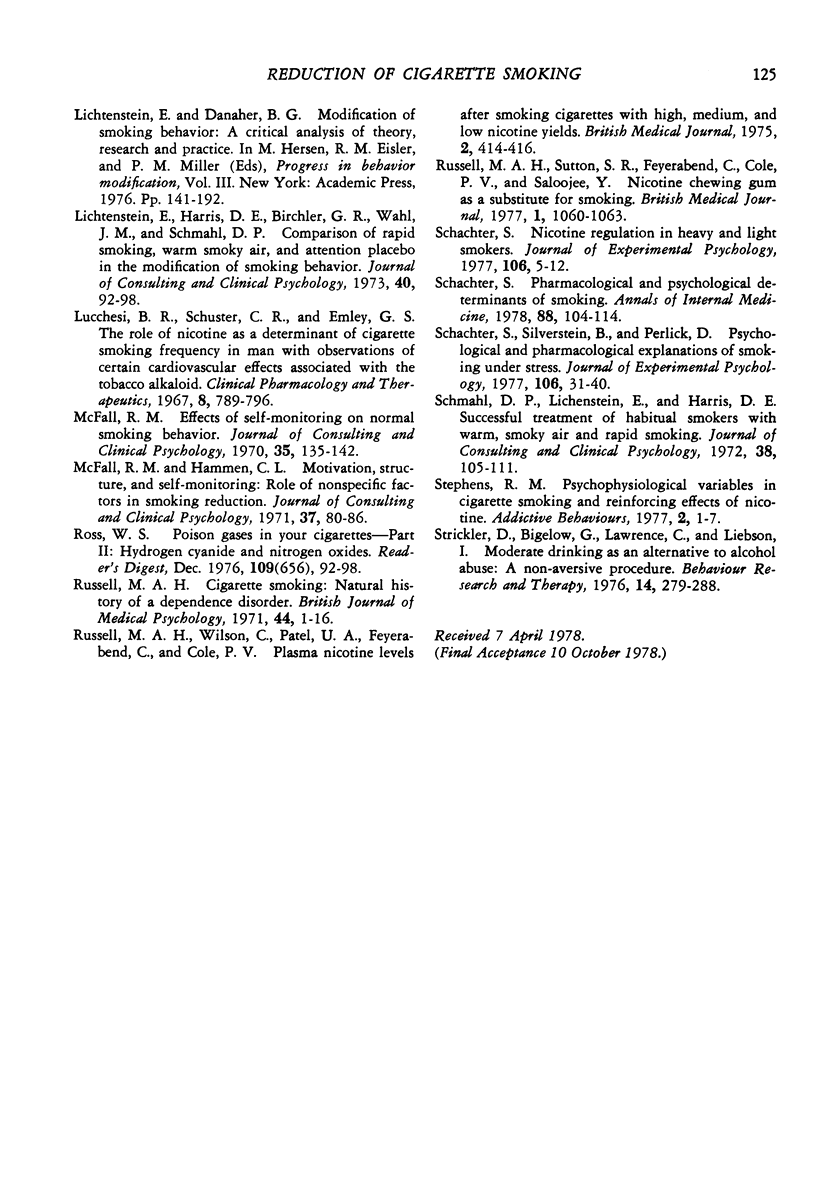
Selected References
These references are in PubMed. This may not be the complete list of references from this article.
- Bernard H. S., Efran J. S. Eliminating versus reducing smoking using pocket timers. Behav Res Ther. 1972 Nov;10(4):399–401. doi: 10.1016/0005-7967(72)90063-0. [DOI] [PubMed] [Google Scholar]
- Delahunt J., Curran J. P. Effectiveness of negative practice and self-control techniques in the reduction of smoking behavior. J Consult Clin Psychol. 1976 Dec;44(6):1002–1007. doi: 10.1037//0022-006x.44.6.1002. [DOI] [PubMed] [Google Scholar]
- Dericco D. A., Brigham T. A., Garlington W. K. Development and evaluation of treatment paradigms for the suppression of smoking behavior. J Appl Behav Anal. 1977 Summer;10(2):173–181. doi: 10.1901/jaba.1977.10-173. [DOI] [PMC free article] [PubMed] [Google Scholar]
- Finnegan J. K., Larson P. S., Haag H. B. THE ROLE OF NICOTINE IN THE CIGARETTE HABIT. Science. 1945 Jul 27;102(2639):94–96. doi: 10.1126/science.102.2639.94. [DOI] [PubMed] [Google Scholar]
- Forbes W. F., Robinson J. C., Hanley J. A., Colburn H. N. Studies on the nicotine exposure of individual smokers. I. Changes in mouth-level exposure to nicotine on switching to lower nicotine cigarettes. Int J Addict. 1976;11(6):933–950. doi: 10.3109/10826087609058819. [DOI] [PubMed] [Google Scholar]
- Frith C. D. The effect of varying the nicotine content of cigarettes on human smoking behaviour. Psychopharmacologia. 1971;19(2):188–192. doi: 10.1007/BF00402641. [DOI] [PubMed] [Google Scholar]
- Goldfarb T. L., Jarvik M. E. Accomodation to restricted tobacco smoke intake in cigarette smokers. Int J Addict. 1972;7(3):559–565. doi: 10.3109/10826087209028108. [DOI] [PubMed] [Google Scholar]
- Goldfarb T. L., Jarvik M. E., Glick S. D. Cigarette nicotine content as a determinant of human smoking behavior. Psychopharmacologia. 1970;17(1):89–93. doi: 10.1007/BF00402094. [DOI] [PubMed] [Google Scholar]
- Gori G. B. Low-risk cigarettes: a prescription. Science. 1976 Dec 11;194(4271):1243–1246. doi: 10.1126/science.996552. [DOI] [PubMed] [Google Scholar]
- Hauser R. Rapid smoking as a technique of behavior modification: caution in selection of subjects. J Consult Clin Psychol. 1974 Aug;42(4):625–626. doi: 10.1037/h0020029. [DOI] [PubMed] [Google Scholar]
- Horan J. J., Hackett G., Nicholas W. C., Linberg S. E., Stone C. I., Lukaski H. C. Rapid smoking: a cautionary note. J Consult Clin Psychol. 1977 Jun;45(3):341–343. [PubMed] [Google Scholar]
- Horan J. J., Linberg S. E., Hackett G. Nicotine poisoning and rapid smoking. J Consult Clin Psychol. 1977 Jun;45(3):344–347. doi: 10.1037//0022-006x.45.3.344. [DOI] [PubMed] [Google Scholar]
- Hunt W. A., Bespalec D. A. An evaluation of current methods of modifying smoking behavior. J Clin Psychol. 1974 Oct;30(4):431–438. doi: 10.1002/1097-4679(197410)30:4<431::aid-jclp2270300402>3.0.co;2-5. [DOI] [PubMed] [Google Scholar]
- KNAPP P. H., BLISS C. M., WELLS H. Addictive aspects in heavy cigarette smoking. Am J Psychiatry. 1963 Apr;119:966–972. doi: 10.1176/ajp.119.10.966. [DOI] [PubMed] [Google Scholar]
- Kumar R., Cooke E. C., Lader M. H., Russell M. A. Is nicotine important to tobacco smoking? Clin Pharmacol Ther. 1977 May;21(5):520–529. doi: 10.1002/cpt1977215520. [DOI] [PubMed] [Google Scholar]
- Lando H. A. Successful treatment of smokers with a broad-spectrum behavioral approach. J Consult Clin Psychol. 1977 Jun;45(3):361–366. doi: 10.1037//0022-006x.45.3.361. [DOI] [PubMed] [Google Scholar]
- Lichtenstein E., Harris D. E., Birchler G. R., Wahl J. M., Schmahl D. P. Comparison of rapid smoking, warm, smoky air, and attention placebo in the modification of smoking behavior. J Consult Clin Psychol. 1973 Feb;40(1):92–98. doi: 10.1037/h0034039. [DOI] [PubMed] [Google Scholar]
- Lucchesi B. R., Schuster C. R., Emley G. S. The role of nicotine as a determinant of cigarette smoking frequency in man with observations of certain cardiovascular effects associated with the tobacco alkaloid. Clin Pharmacol Ther. 1967 Nov-Dec;8(6):789–796. doi: 10.1002/cpt196786789. [DOI] [PubMed] [Google Scholar]
- McFall R. M. Effects of self-monitoring on normal smoking behavior. J Consult Clin Psychol. 1970 Oct;35(2):135–142. doi: 10.1037/h0030087. [DOI] [PubMed] [Google Scholar]
- McFall R. M., Hammen C. L. Motivation, structure, and self-monitoring: role of nonspecific factors in smoking reduction. J Consult Clin Psychol. 1971 Aug;37(1):80–86. doi: 10.1037/h0031279. [DOI] [PubMed] [Google Scholar]
- Russell M. A. Cigarette smoking: natural history of a dependence disorder. Br J Med Psychol. 1971 Mar;44(1):1–16. doi: 10.1111/j.2044-8341.1971.tb02141.x. [DOI] [PubMed] [Google Scholar]
- Russell M. A., Sutton S. R., Feyerabend C., Cole P. V., Saloojee Y. Nicotine chewing gum as a substitute for smoking. Br Med J. 1977 Apr 23;1(6068):1060–1063. doi: 10.1136/bmj.1.6068.1060. [DOI] [PMC free article] [PubMed] [Google Scholar]
- Russell M. A., Wilson C., Patel U. A., Feyerabend C., Cole P. V. Plasma nicotine levels after smoking cigarettes with high, medium, and low nicotine yields. Br Med J. 1975 May 24;2(5968):414–416. doi: 10.1136/bmj.2.5968.414. [DOI] [PMC free article] [PubMed] [Google Scholar]
- Schachter S. Pharmacological and psychological determinants of smoking. A New York University honors program lecture. Ann Intern Med. 1978 Jan;88(1):104–114. doi: 10.7326/0003-4819-88-1-104. [DOI] [PubMed] [Google Scholar]
- Schachter S., Silverstein B., Perlick D. 5. Psychological and pharmacological explanations of smoking under stress. J Exp Psychol Gen. 1977 Mar;106(1):31–40. doi: 10.1037//0096-3445.106.1.31. [DOI] [PubMed] [Google Scholar]
- Schmahl D. P., Lichtenstein E., Harris D. E. Successful treatment of habitual smokers with warm, smoky air and rapid smoking. J Consult Clin Psychol. 1972 Feb;38(1):105–111. doi: 10.1037/h0032413. [DOI] [PubMed] [Google Scholar]
- Stephens R. M. Psychophysiological variables in cigarette smoking and reinforcing effects of nicotine. Addict Behav. 1977;2(1):1–7. doi: 10.1016/0306-4603(77)90002-8. [DOI] [PubMed] [Google Scholar]
- Strickler D., Bigelow G., Lawrence C., Liebson I. Moderate drinking as an alternative to alcohol abuse: a non-aversive procedure. Behav Res Ther. 1976;14(4):279–283. doi: 10.1016/0005-7967(76)90003-6. [DOI] [PubMed] [Google Scholar]


